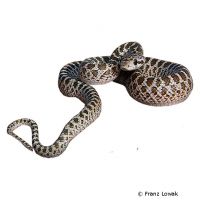Texas Glossy Snake (Arizona elegans)
| Texas Glossy Snake Arizona elegans | |
|---|---|
| Name | Texas Glossy Snake |
| Name Lat. | Arizona elegans |
| Family | Colubrids |
| Family lat. | Colubridae |
| Order | Scaled Reptiles |
| Order lat. | Squamata |
| Origin | North America |
| Habitat | Dry savanna |
| Diet | Small mammals |
| Humidity | 40-60 % |
| Behavior | Nocturnal; peaceful |
| Keeping | Individual, pair |
| Care Level | Easy |
| Reproduction | Oviparous |
| Housing | Dry terrarium |
| Life Span | 10-15 years |
| Protection | No |
| Metric Units | |
| Size | 100-150 cm |
| Temperature | 24-28 °C |
| Temperature Local | 30-35 °C |
| Housing Size | 150 x 80 x 80 cm |
| US Units | |
| Size | 39"-59" |
| Temperature | 75-82 °F |
| Temperature Local | 86-95 °F |
| Housing Size | 60" x 30" x 30" |
Distribution and habitat
The range of the ground-dwelling, predominantly nocturnal Arizona snakes extends from Nevada (USA) to central Mexico. They live in semi-deserts, dry savannas and scrubland and hide during the day under stones, in caves or bury themselves in the ground.
Maintenance
Minimum dimensions for the terrarium, according to the size and number of animals:
| 1-2 animals | 1KL x 0,5KL x 0,5KL (L x W x H) |
Body length (KL) is measured on the largest animal. For each additional animal the floor space should be increased by 20%. A terrarium of e.g. L 150 x W 80 x H 80 cm is recommended, which should be placed in a quiet and vibration-free place.
They need a terrarium structured with roots, stones, climbing branches and cork tubes (hiding places and visual protection), a graveable substrate, e.g. of sand-clay mixture with peat and foliage, as well as a small, easy to clean drinking vessel. A small portion of the substrate should always be kept moist. Several times a week, preferably in the evening, the inside of the terrarium should be finely sprayed with water (humidity).
| Temp. day: 24-28 °C | Temp. night: 18-22 °C | Temp. local: up to 35 °C | Humidity: 40-60 |
Thermostatically controlled floor heating is recommended. Lighting duration must be 12-14 hrs depending on the season. Daylight fluorescent tubes supplemented with spotlights are ideal.
Diet
According to their size they feed on small lizards and rodents (e.g. mice, rats) as well as nest young chicks. After successful acclimation, they often succeed in switching to dead food animals (commercially available frozen food). Juveniles should be offered food every 3-5 days, adults every 7-14 days, with occasional periods of fasting (e.g., skipping a feeding). If the snake is disturbed after feeding, this may result in vomiting of the prey. It is better to offer several small feeders, rather than one large one. If it does not eat for a long period of time, both the timing and the food should be varied. It is important to fortify the food animals with vitamins and minerals. Since the snake could be injured by live rodents, it should not be left unattended with them.
A varied diet promotes health and prevents deficiency symptoms.
Reproduction and breeding
Probing by the veterinarian is the only reliable method of sex determination.
The female lays her eggs (3-23 pieces) in the moist, about 5 cm deep substrate and does not engage in brood care. The incubation period is 60-75 days at a temperature of 24-26 °C.
The life expectancy can be 15-20 years.
Important
They are calm and easy to handle, but very shy. Caution is advised when socializing, as they occasionally eat smaller conspecifics and also other smaller snakes
Recommended is a hibernation period of 2-3 months at a temperature of 7-12 °C accompanied by a feeding break.Always have snake hooks and protective gloves ready when handling.The terrarium must have good ventilation without drafts and meet the species-specific needs. Measuring devices such as thermometers, hygrometers, etc. are necessary. The lighting has to correspond to the species-specific day-night rhythm and has to be placed in such a way that the animals cannot injure themselves. The terrarium should be locked in such a way that neither unauthorized persons can open it nor the animals can escape. Contamination must be removed regularly
Further literature can be found in your pet store.
References
Text: Christian Sänger; Image: petdata
Source: BMELV (1997): Tierschutzgutachten - Mindestanforderungen an die Haltung von Reptilien; ENGELMANN (2006): Zootierhaltung - Tiere in menschlicher Obhut: Reptilien und Amphibien, Harri Deutsch Verlag
- Gemäß § 21 Abs. 5 Tierschutzgesetz idgF
